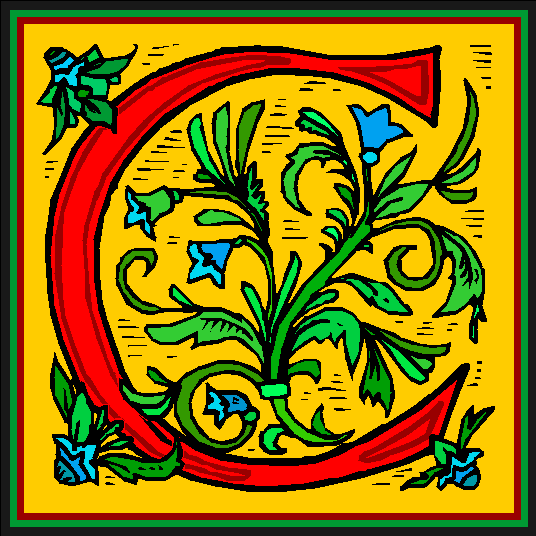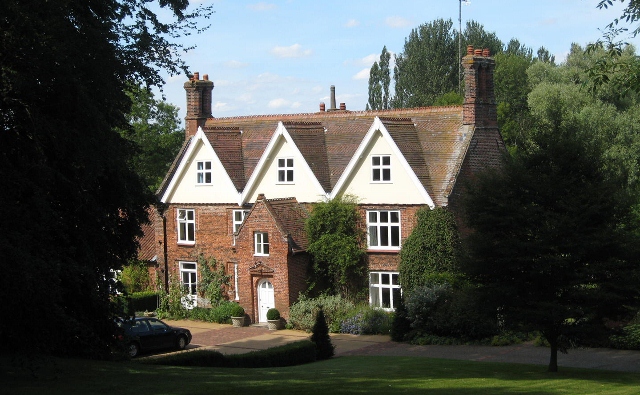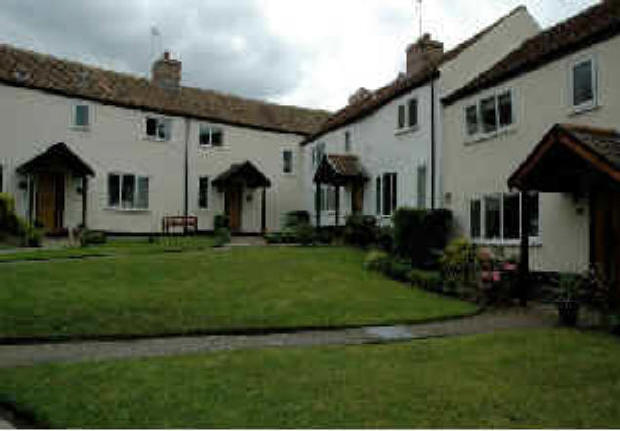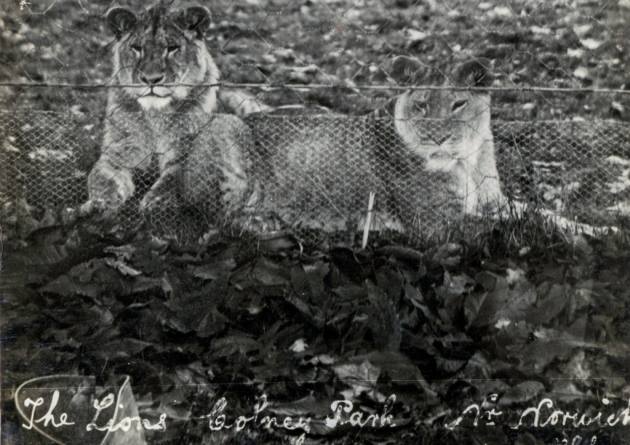Bawburgh Village
History Alphabet
See the Church Page

is, of course, for the Church
C is for the Costessey Connection,
Costessey,a suburb of Norwich, a few miles away, but inextricably linked
to Bawburgh through the years, as much of the village belonged to the Costessey
Estate, including Bawburgh Hall
C is for Church Farmhouse

Sitting on low lying land to the north of the Church and with the auspicious
neighbour of Saint Walstan’s Well, Church Farmhouse is certainly visually a
magnificent house, with an equally fascinating history. Not so obviously, it
has not housed the Vicar of the day, since medieval times, when it was necessary
for six Priests to be accommodated there to deal with the hundreds of pilgrims
to the Well. Since then, it has simply been Church Farm. There are records of
a house on the spot since 1278 and the present 2-foot thick back wall dated
as 13th century ties in well with this. Church Cottage housed vicars until around
1813, when Rectory House on Watton Road, and then the new Vicarage in Little
Melton were used. In the meantime the tenants of Church Farm have been closely
associated with the Church. Church Farm was not transferred from ownership of
the Church until 1820, when the Unthank family, and then Intwood Estates took
over. The Unthank family, of Intwood Hall, never lived in the house, but instead
a succession of tenant farmers, until in 1979, when the Hannison family took
over ownership. There has been two more changes, the Green family and more recently,
in 2017, Caroline and Laurence Blake moved in.
Thankfully all residents have taken their responsibilities of ownership
and restoration very seriously. The property is a Grade II* (with star) Listed
Building and continues its association with Church and Well, with the continuation
of Saint Walstan’s Day celebrations at the Well in the wonderful garden.
Above information thanks to the Greens and Geoffrey Kelly’s research of 1988.
C is for Childs Terrace
 This attractive set of cottages, is symbolic of changes through difficult and
better times for the village. Built during the 17th century (although with an
even older retaining wall going back to medieval times), the terrace was
known as the Poor Yard, even in living memory. It was during the Sixties that
demolition was ordered, but they did not account for the determination of the
last tenant—Mrs. Mabel Holmes. Fortunately by the time she did eventually move
to Hockering Lane, the village was by then subject to the Conservation Report
of 1973, which promised to preserve the character and seek to improve the village
by encouraging schemes to restore decaying buildings. This was timely, in that
not only was Childs Terrace ready for demolition, the Kings Head and Blacksmiths
Cottage were in need of care and attention too. Early during the twentieth century
the Terrace was home to eight families, the Mortimers had to occupy two of them
(although inconveniently not adjoining!). Mostly employment would have been
at the nearby Mill, and the cottages owned by it—thus the name of Childs, Millers
during that time. With the restoration work during the Seventies, the nine cottages
became five, and something not needed before—a garage block for five cars too.
The work was carried out by Carters, and restoration completed in 1977. With
the arrival of the Goodmans at numbers one and two in 2005, the frontage and
gardens have excellent new caretakers! All this thanks to Mrs. Holmes.
This attractive set of cottages, is symbolic of changes through difficult and
better times for the village. Built during the 17th century (although with an
even older retaining wall going back to medieval times), the terrace was
known as the Poor Yard, even in living memory. It was during the Sixties that
demolition was ordered, but they did not account for the determination of the
last tenant—Mrs. Mabel Holmes. Fortunately by the time she did eventually move
to Hockering Lane, the village was by then subject to the Conservation Report
of 1973, which promised to preserve the character and seek to improve the village
by encouraging schemes to restore decaying buildings. This was timely, in that
not only was Childs Terrace ready for demolition, the Kings Head and Blacksmiths
Cottage were in need of care and attention too. Early during the twentieth century
the Terrace was home to eight families, the Mortimers had to occupy two of them
(although inconveniently not adjoining!). Mostly employment would have been
at the nearby Mill, and the cottages owned by it—thus the name of Childs, Millers
during that time. With the restoration work during the Seventies, the nine cottages
became five, and something not needed before—a garage block for five cars too.
The work was carried out by Carters, and restoration completed in 1977. With
the arrival of the Goodmans at numbers one and two in 2005, the frontage and
gardens have excellent new caretakers! All this thanks to Mrs. Holmes.
C is for Colney Hall
 Colney
Hall was built between 1767 and 1781 by a rich wool merchant.
It was extended and an artificial grotto added in the 1800s by Hugh Gurney Barclay,
vice-chancellor of Barclays Bank, and High Sheriff of Norwich.
In 1960 the Hall was partly demolished and is now home to Global Diagnostics.
When Jenny Press first came to Bawburgh, she was told by an elderly resident that at one time,
villagers who were employed by Colney Hall, would walk to work across the fields and over a little bridge.
Sadly the bridge has long since gone.
Edith Cavell was at one time employed as governess to the Gurney children, before serving as a nurse during the First World War.
She was executed by the Germans for helping allied soldiers escape from German occupied Belgium.
A well known local story is that of the Colney Hall lions. During a Kenyan safari, Hugh Gurney was presented with two lion cubs by a German Count.
They were transported to Norfolk by train, then onward to Colney Hall on a farm cart. The family named the cubs Fritz and Mitzi.
They were friendly and gentle and treated as family pets.
Mr. Barclay’s daughter Phyllis would feed and play with them and they were allowed to roam freely in the grounds around the Hall,
although they did sometimes frighten unsuspecting visitors and trades people.
But during Christmas in 1911, Lieutenant Terrence Barclay, the 29 year old soldier son of the family, was home on leave when Fritz attacked him, probably just in rough play.
The game keeper grabbed his gun and fired a shot to frighten Fritz, while Phyllis dragged her brother to safety.
Terence wasn’t badly hurt but he died of blood poisoning on December 27th that same year. The lions were hurriedly given to Dublin Zoo.
The Barclay family had many connections with Bawburgh,
in 1919 several cottages in the village were put up for sale by the Costessey Estate and bought by Mr. Barclay,
and during the following year he unveiled the War Memorial at Bawburgh Church.
Colney
Hall was built between 1767 and 1781 by a rich wool merchant.
It was extended and an artificial grotto added in the 1800s by Hugh Gurney Barclay,
vice-chancellor of Barclays Bank, and High Sheriff of Norwich.
In 1960 the Hall was partly demolished and is now home to Global Diagnostics.
When Jenny Press first came to Bawburgh, she was told by an elderly resident that at one time,
villagers who were employed by Colney Hall, would walk to work across the fields and over a little bridge.
Sadly the bridge has long since gone.
Edith Cavell was at one time employed as governess to the Gurney children, before serving as a nurse during the First World War.
She was executed by the Germans for helping allied soldiers escape from German occupied Belgium.
A well known local story is that of the Colney Hall lions. During a Kenyan safari, Hugh Gurney was presented with two lion cubs by a German Count.
They were transported to Norfolk by train, then onward to Colney Hall on a farm cart. The family named the cubs Fritz and Mitzi.
They were friendly and gentle and treated as family pets.
Mr. Barclay’s daughter Phyllis would feed and play with them and they were allowed to roam freely in the grounds around the Hall,
although they did sometimes frighten unsuspecting visitors and trades people.
But during Christmas in 1911, Lieutenant Terrence Barclay, the 29 year old soldier son of the family, was home on leave when Fritz attacked him, probably just in rough play.
The game keeper grabbed his gun and fired a shot to frighten Fritz, while Phyllis dragged her brother to safety.
Terence wasn’t badly hurt but he died of blood poisoning on December 27th that same year. The lions were hurriedly given to Dublin Zoo.
The Barclay family had many connections with Bawburgh,
in 1919 several cottages in the village were put up for sale by the Costessey Estate and bought by Mr. Barclay,
and during the following year he unveiled the War Memorial at Bawburgh Church.
 This attractive set of cottages, is symbolic of changes through difficult and
better times for the village. Built during the 17th century (although with an
even older retaining wall going back to medieval times), the terrace was
known as the Poor Yard, even in living memory. It was during the Sixties that
demolition was ordered, but they did not account for the determination of the
last tenant—Mrs. Mabel Holmes. Fortunately by the time she did eventually move
to Hockering Lane, the village was by then subject to the Conservation Report
of 1973, which promised to preserve the character and seek to improve the village
by encouraging schemes to restore decaying buildings. This was timely, in that
not only was Childs Terrace ready for demolition, the Kings Head and Blacksmiths
Cottage were in need of care and attention too. Early during the twentieth century
the Terrace was home to eight families, the Mortimers had to occupy two of them
(although inconveniently not adjoining!). Mostly employment would have been
at the nearby Mill, and the cottages owned by it—thus the name of Childs, Millers
during that time. With the restoration work during the Seventies, the nine cottages
became five, and something not needed before—a garage block for five cars too.
The work was carried out by Carters, and restoration completed in 1977. With
the arrival of the Goodmans at numbers one and two in 2005, the frontage and
gardens have excellent new caretakers! All this thanks to Mrs. Holmes.
This attractive set of cottages, is symbolic of changes through difficult and
better times for the village. Built during the 17th century (although with an
even older retaining wall going back to medieval times), the terrace was
known as the Poor Yard, even in living memory. It was during the Sixties that
demolition was ordered, but they did not account for the determination of the
last tenant—Mrs. Mabel Holmes. Fortunately by the time she did eventually move
to Hockering Lane, the village was by then subject to the Conservation Report
of 1973, which promised to preserve the character and seek to improve the village
by encouraging schemes to restore decaying buildings. This was timely, in that
not only was Childs Terrace ready for demolition, the Kings Head and Blacksmiths
Cottage were in need of care and attention too. Early during the twentieth century
the Terrace was home to eight families, the Mortimers had to occupy two of them
(although inconveniently not adjoining!). Mostly employment would have been
at the nearby Mill, and the cottages owned by it—thus the name of Childs, Millers
during that time. With the restoration work during the Seventies, the nine cottages
became five, and something not needed before—a garage block for five cars too.
The work was carried out by Carters, and restoration completed in 1977. With
the arrival of the Goodmans at numbers one and two in 2005, the frontage and
gardens have excellent new caretakers! All this thanks to Mrs. Holmes.

 Colney
Hall was built between 1767 and 1781 by a rich wool merchant.
It was extended and an artificial grotto added in the 1800s by Hugh Gurney Barclay,
vice-chancellor of Barclays Bank, and High Sheriff of Norwich.
In 1960 the Hall was partly demolished and is now home to Global Diagnostics.
When Jenny Press first came to Bawburgh, she was told by an elderly resident that at one time,
villagers who were employed by Colney Hall, would walk to work across the fields and over a little bridge.
Sadly the bridge has long since gone.
Edith Cavell was at one time employed as governess to the Gurney children, before serving as a nurse during the First World War.
She was executed by the Germans for helping allied soldiers escape from German occupied Belgium.
A well known local story is that of the Colney Hall lions. During a Kenyan safari, Hugh Gurney was presented with two lion cubs by a German Count.
They were transported to Norfolk by train, then onward to Colney Hall on a farm cart. The family named the cubs Fritz and Mitzi.
They were friendly and gentle and treated as family pets.
Mr. Barclay’s daughter Phyllis would feed and play with them and they were allowed to roam freely in the grounds around the Hall,
although they did sometimes frighten unsuspecting visitors and trades people.
But during Christmas in 1911, Lieutenant Terrence Barclay, the 29 year old soldier son of the family, was home on leave when Fritz attacked him, probably just in rough play.
The game keeper grabbed his gun and fired a shot to frighten Fritz, while Phyllis dragged her brother to safety.
Terence wasn’t badly hurt but he died of blood poisoning on December 27th that same year. The lions were hurriedly given to Dublin Zoo.
The Barclay family had many connections with Bawburgh,
in 1919 several cottages in the village were put up for sale by the Costessey Estate and bought by Mr. Barclay,
and during the following year he unveiled the War Memorial at Bawburgh Church.
Colney
Hall was built between 1767 and 1781 by a rich wool merchant.
It was extended and an artificial grotto added in the 1800s by Hugh Gurney Barclay,
vice-chancellor of Barclays Bank, and High Sheriff of Norwich.
In 1960 the Hall was partly demolished and is now home to Global Diagnostics.
When Jenny Press first came to Bawburgh, she was told by an elderly resident that at one time,
villagers who were employed by Colney Hall, would walk to work across the fields and over a little bridge.
Sadly the bridge has long since gone.
Edith Cavell was at one time employed as governess to the Gurney children, before serving as a nurse during the First World War.
She was executed by the Germans for helping allied soldiers escape from German occupied Belgium.
A well known local story is that of the Colney Hall lions. During a Kenyan safari, Hugh Gurney was presented with two lion cubs by a German Count.
They were transported to Norfolk by train, then onward to Colney Hall on a farm cart. The family named the cubs Fritz and Mitzi.
They were friendly and gentle and treated as family pets.
Mr. Barclay’s daughter Phyllis would feed and play with them and they were allowed to roam freely in the grounds around the Hall,
although they did sometimes frighten unsuspecting visitors and trades people.
But during Christmas in 1911, Lieutenant Terrence Barclay, the 29 year old soldier son of the family, was home on leave when Fritz attacked him, probably just in rough play.
The game keeper grabbed his gun and fired a shot to frighten Fritz, while Phyllis dragged her brother to safety.
Terence wasn’t badly hurt but he died of blood poisoning on December 27th that same year. The lions were hurriedly given to Dublin Zoo.
The Barclay family had many connections with Bawburgh,
in 1919 several cottages in the village were put up for sale by the Costessey Estate and bought by Mr. Barclay,
and during the following year he unveiled the War Memorial at Bawburgh Church.